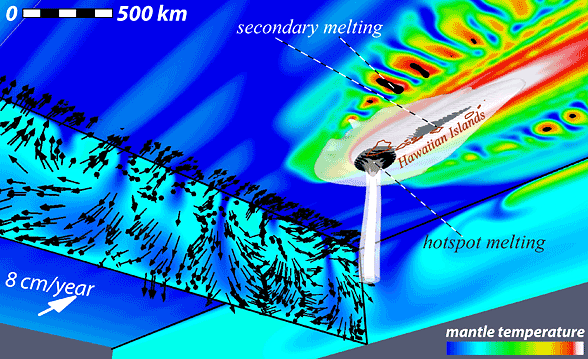Convection explains hot spot observations
July 20th, 2011 | by Cheryl Ernst | Published in Research News

Current theories about mantle plumes cannot explain the full range of observations related to the Hawaiian hotspot, including variations in the amount of erupted material over time, secondary volcanism that created features such as Diamond Head and chemical differences in the makeup of Mauna Loa and Mauna Kea volcanoes.
A new study by researchers in the University of Hawaiʻi at Mānoa School of Ocean and Earth Science and Technology suggests the answer may lie in small scale convection, convective rolls of the mantle that carry heat from Earth’s interior to the base of the Pacific plate.
Postdoctoral Researcher Maxim Ballmer and colleagues simulated small scale convection in a model of mantle plume dynamics. Their geodynamic model successfully predicts a large range of observations, including arch volcanism well away from the islands, says Ballmer’s advisor and Professor of Geology and Geophysics Garrett Ito.
“Our results show that shallow processes have an important influence on the character of volcanism fed by deep-rooted mantle plumes,” the team writes in the June 26, 2011, edition of Nature Geoscience.
The findings provide insight into the origin of volcanism away from plate boundaries composition and dynamics of the mantle, which in turn may contribute to our understanding of the early days of the planet and the origin of water and life, Ballmer adds.
The research team will next simulate a hot, dense thermochemical mantle plume, which in some ways behaves like the upwellings in lava lamps, to see if the model can explain characteristics of the Hawaiian plume described in the seismic earthquake tomography studies of SOEST colleague Cecily Wolfe.
Read the abstract in Nature Geoscience.
Tags: geology, geophysics, School of Ocean and Earth Science and Technology, UH Manoa
